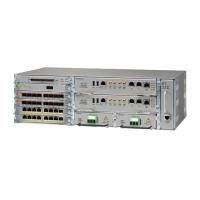The intra-building port(s) of the equipment or subassembly must not be metallically connected to interfaces
that connect to the OSP or its wiring. These interfaces are designed for use as intra-building interfaces
only (Type 2 or Type 4 ports as described in GR-1089-CORE) and require isolation from the exposed
OSP cabling. The addition of Primary Protectors is not sufficient protection in order to connect these
interfaces metallically to OSP wiring. Statement 7005
Warning
Follow these steps to connect the cable to a copper Gigabit Ethernet port:
SUMMARY STEPS
1.
Confirm that the router is powered off.
2.
Connect one end of the cable to the Gigabit Ethernet port on the router.
3.
Connect the other end to the BTS patch or demarcation panel at your site.
DETAILED STEPS
Step 1
Confirm that the router is powered off.
Step 2
Connect one end of the cable to the Gigabit Ethernet port on the router.
Step 3
Connect the other end to the BTS patch or demarcation panel at your site.
Connecting Cables to SFP Modules
For information on connecting cables to Cisco optical and Ethernet SFP interfaces, see:
http://www.cisco.com/en/US/partner/products/hw/modules/ps5455/prod_installation_guides_list.html
Connecting the Fan Tray Alarm Port
The fan tray includes an alarm port that maps to 4 dry contact alarm inputs.
The pins on the alarm port are passive signals and can be configured as Normally Open (an alarm generated
when current is interrupted) or Normally Closed (an alarm is generated when a circuit is established) alarms.
You can configure each alarm input as critical, major, or minor. An alarm triggers alarm LEDs and alarm
messages. The relay contacts can be controlled through any appropriate third-party relay controller. The
open/close configuration is an option controlled in Cisco IOS software.
The intra-building port(s) of the equipment or subassembly must not be metallically connected to interfaces
that connect to the OSP or its wiring. These interfaces are designed for use as intra-building interfaces
only (Type 2 or Type 4 ports as described in GR-1089-CORE) and require isolation from the exposed
OSP cabling. The addition of Primary Protectors is not sufficient protection in order to connect these
interfaces metallically to OSP wiring. Statement 7005
Warning
Cisco ASR 9000 Series Aggregation Services Router Satellite Systems Installation Guide
65
Installing the Cisco ASR 903 Router as a Satellite Shelf
Connecting Cables to SFP Modules

